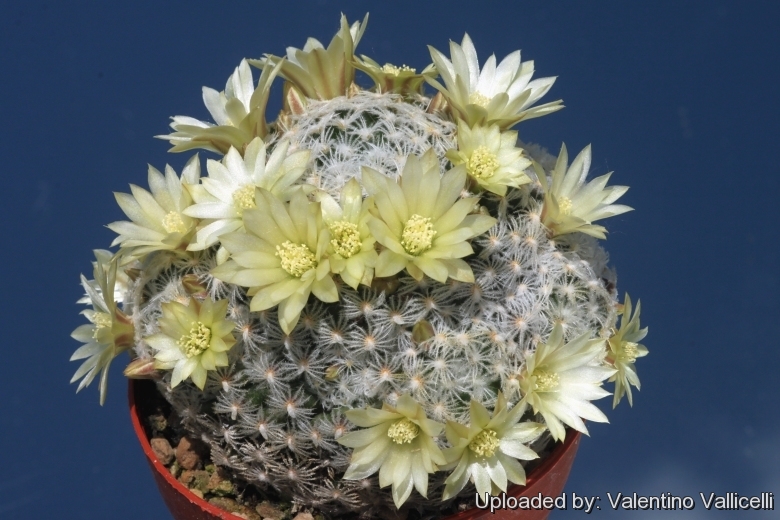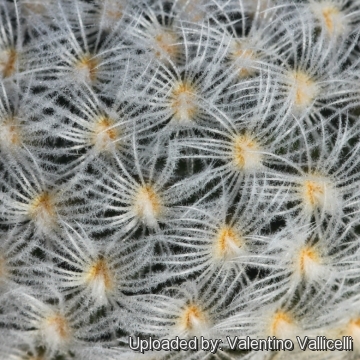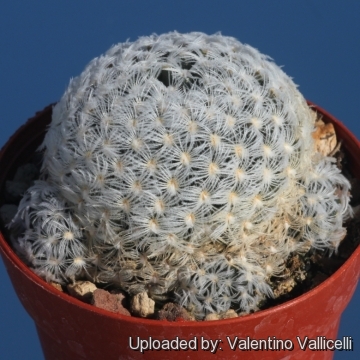




Your support is critical to our success.
= Mammillaria crinita subs. duwei f. inermis hort.
Accepted Scientific Name: Mammillaria crinita subs. duwei (Rogoz. & P.J.Braun)
[Basionym: Mammillaria duwei Rogoz. & P.J.Braun 1985]

Origin and Habitat: Mexico (Guanajuato and Queretaro)
Habitat: Altitude 1.800 - 2.000 m.
Note: The form "inermis" is has been obtained in cultivation from selected plants without central spines.
Synonyms:
Mammillaria crinita DC.
Mém. Mus. Hist. Nat. 17: 112. 1828
Synonymy: 50
- Mammillaria crinita DC.
- Cactus crinitus (DC.) Kuntze
- Chilita crinita (DC.) Buxb.
- Ebnerella crinita (DC.) Buxb.
- Krainzia crinita (DC.) Doweld
- Mammillaria glochidiata var. crinita (DC.) K.Schum.
- Mammillaria glochidiata f. crinita (DC.) Schelle
- Mammillaria aureoviridis Heinrich
- Mammillaria brevicrinita Repp.
- Mammillaria cadereytana Backeb.
- Mammillaria calleana Backeb.
- Mammillaria criniformis DC.
- Chilita criniformis (DC.) Buxb.
- Mammillaria criniformis var. albida DC.
- Mammillaria erectohamata Boed.
- Chilita erectohamata (Boed.) Buxb.
- Ebnerella erectohamata (Boed.) Buxb.
- Mammillaria felipensis Repp.
- Mammillaria gilensis Boed.
- Chilita gilensis (Boed.) Buxb.
- Ebnerella gilensis (Boed.) Buxb.
- Mammillaria glochidiata var. xiloensis Repp.
- Mammillaria moeller-valdeziana Appenz.
- Mammillaria mollihamata Shurly
- Mammillaria puberula Repp.
- Mammillaria pubispina Boed.
- Chilita pubispina (Boed.) Buxb.
- Ebnerella pubispina (Boed.) Buxb.
- Mammillaria pygmaea (Britton & Rose) A.Berger
- Chilita pygmaea (Britton & Rose) Buxb.
- Ebnerella pygmaea (Britton & Rose) Buxb.
- Neomammillaria pygmaea Britton & Rose
- Mammillaria scheinvariana R.Ortega V. & Glass
- Mammillaria crinita subs. scheinvariana (R.Ortega V. & Glass) W.A.Fitz Maur. & B.Fitz Maur.
- Mammillaria schelhasii Pfeiff.
- Cactus schelhasii (Pfeiff.) Kuntze
- Chilita schelhasii (Pfeiff.) Orcutt
- Ebnerella schelhasii (Pfeiff.) Buxb.
- Mammillaria schelhasei Pfeiff. Pfeiff.
- Neomammillaria schelhasii (Pfeiff.) Britton & Rose
- Mammillaria schelhasii var. triuncinata Salm-Dyck
- Mammillaria schelhasei f. triuncinata (Salm-Dyck) Schelle
- Mammillaria tezontle W.A.Fitz Maur. & B.Fitz Maur.
- Mammillaria variabilis Repp.
- Mammillaria zeilmanniana Boed.
- Chilita zeilmanniana (Boed.) Buxb.
- Ebnerella zeilmanniana (Boed.) Buxb.
- Mammillaria crinita f. zeilmanniana (Boed.) Glass
- Neomammillaria zeilmanniana (Boed.) Y.Itô
- Mammillaria zeilmanniana f. albiflora hort.
Mammillaria crinita subs. duwei (Rogoz. & P.J.Braun)
[Basionym: Mammillaria duwei Rogoz. & P.J.Braun 1985]
Synonymy: 10
- Mammillaria crinita subs. duwei (Rogoz. & P.J.Braun)
- Mammillaria duwei Rogoz. & P.J.Braun
- Mammillaria nana subs. duwei (Rogoz. & P.J.Braun) Pilbeam
- Mammillaria trichacantha subs. duwei (Rogoz. & P.J.Braun) Mottram
- Mammillaria crinita subs. duwei f. cristata hort.
- Mammillaria crinita subs. duwei f. inermis hort.
- Mammillaria crinita subs. duwei f. monstruosa hort.
Mammillaria crinita subs. leucantha (Boed.) D.R.Hunt
Mammillaria Postscripts 6: 6 (1997)
Synonymy: 8
- Mammillaria crinita subs. leucantha (Boed.) D.R.Hunt
- Krainzia crinita subs. leucantha (Boed.) Doweld
- Mammillaria leucantha Boed.
- Mammillaria aurihamata Boed.
- Chilita aurihamata (Boed.) Buxb.
- Ebnerella aurihamata (Boed.) Buxb.
- Mammillaria schelhasii var. aurihamata (Boed.) Repp.
- Neomammillaria aurihamata (Boed.) Y.Itô
Mammillaria crinita f. nana (Backeb.)
[Basionym: Mammillaria nana Backeb. 1966 ]
Synonymy: 9
- Mammillaria crinita f. nana (Backeb.)
- Mammillaria nana Backeb.
- Mammillaria monancistracantha Backeb.
- Mammillaria rawlii hort.
- Mammillaria trichacantha K.Schum.
- Chilita trichacantha (K.Schum.) Buxb.
- Ebnerella trichacantha (K.Schum.) Buxb.
- Mammillaria nana trichacantha hort.
- Neomammillaria trichacantha (K.Schum.) Britton & Rose
Mammillaria crinita subs. painteri (Rose) U.Guzmán
Cactaceae Syst. Init. 16: 18 (11 Oct. 2003) Remarks: first published in U.Guzmán et al., Catálogo Cact. Mex.: 120 (May 2003), without basionym reference
Synonymy: 9
- Mammillaria crinita subs. painteri (Rose) U.Guzmán
- Chilita painteri (Rose) Buxb.
- Ebnerella painteri (Rose) Buxb.
- Mammillaria painteri Rose
- Neomammillaria painteri (Rose) Britton & Rose
- Mammillaria crinita subs. painteri f. monstruosa cristata hort.
- Mammillaria crinita subs. painteri f. monstruosa hort.
Description: Mammillaria duweiSN|8895]]SN|8895]] is a small solitary rarely offsetting plants that eventually forms tiny mounds. The form "inermis" is a selected strain with pure feathery radial spines lacking central spines.
Stems: Heads 3,5 to 6 cm in diameter, 2 - 4 cm high, dark green, soft, globoid, flattened-globose, to shortly cylindrical.
Tubercles: Small, clavate 4-5 mm high, With a woolly axil and little hair.
Central spines: Absent.
Radial spines: 28 - 36, acicular, thin, white, brownish at base, pubescent/feathery, 3,5 - 4 mm long, interlacing and densely wrapped against the body of the cactus
Flowers: Funnel-form, less deeply set, yellowish/cream to light yellow, about 20 mm long and in diameter. Inner segments lanceolate, widely spreading, accuminate, style and stigma lobes greenish.
Blooming season: Flowers readily, and for a long period from spring to the early summer.
Fruits: Light red to red, elongated.
Seeds: Blackish brown.
Subspecies, varieties, forms and cultivars of plants belonging to the Mammillaria crinita complex
 Mammillaria aurihamata Boed.: has golden yellow hooked central spines. Distribution: Mexico, where it occurs in San Luis Potosi, near Real de Catorce.
Mammillaria aurihamata Boed.: has golden yellow hooked central spines. Distribution: Mexico, where it occurs in San Luis Potosi, near Real de Catorce.  Mammillaria brevicrinita Repp.: (Mammillaria crinita) Radial spines 10 - 29, white, finely pubescent, 6 - 9 mm long.
Mammillaria brevicrinita Repp.: (Mammillaria crinita) Radial spines 10 - 29, white, finely pubescent, 6 - 9 mm long.
Central spines: 0 - 7, awl-shaped, yellowish to red to dark brown, 8-16 mm long, one or two hooked.- Mammillaria crinita DC.: This taxon comprises a very variable a complex of forms, variety and species with varible spination. The flowers cream colored to a pink-cream colored. This is one of the most prolific bloomers among the Mammillarias.
 Mammillaria crinita subs. duwei (Rogoz. & P.J.Braun): It is a small cactus with delicate near harmless feathery spines densely wrapped against the body of the cactus. The long central spine is not present on all the clones, they are yellowish, hooked, to 8 mm long, pubescent. The flowers are yellowish/cream to light yellow.
Mammillaria crinita subs. duwei (Rogoz. & P.J.Braun): It is a small cactus with delicate near harmless feathery spines densely wrapped against the body of the cactus. The long central spine is not present on all the clones, they are yellowish, hooked, to 8 mm long, pubescent. The flowers are yellowish/cream to light yellow. Mammillaria crinita subs. duwei f. cristata hort.: crested form completely covered by tight pubescent spines.
Mammillaria crinita subs. duwei f. cristata hort.: crested form completely covered by tight pubescent spines. Mammillaria crinita subs. duwei f. inermis hort.: this is a selected strain with pure feathery radial spines (central spines absent)
Mammillaria crinita subs. duwei f. inermis hort.: this is a selected strain with pure feathery radial spines (central spines absent) Mammillaria crinita subs. duwei f. monstruosa hort.: This is a true oddity and some say that this monster is nothing else than a abnormal root grafted upside down.
Mammillaria crinita subs. duwei f. monstruosa hort.: This is a true oddity and some say that this monster is nothing else than a abnormal root grafted upside down.- Mammillaria crinita f. nana (Backeb.)
- Mammillaria crinita subs. painteri (Rose) U.Guzmán: has red, brown or coffee coloured central spines. With age it may offset from the base to form a small cluster. Distribution: Queretaro and adjacent areas in Hidalgo and Guanajuato.
 Mammillaria crinita subs. painteri f. monstruosa cristata hort.: Crested form. has more bristly spines than the Mammillaria crinita subs. painteri f. monstruosa from which it derives.
Mammillaria crinita subs. painteri f. monstruosa cristata hort.: Crested form. has more bristly spines than the Mammillaria crinita subs. painteri f. monstruosa from which it derives. Mammillaria crinita subs. painteri f. monstruosa hort.: Cultivated mutant characterized by very reduced or absent spines, free branching, and with small pink flowers.
Mammillaria crinita subs. painteri f. monstruosa hort.: Cultivated mutant characterized by very reduced or absent spines, free branching, and with small pink flowers. Mammillaria glochidiata var. xiloensis Repp.: (Mammillaria crinita) Plants irregularly forming tightly packed cluster of egg-shaped balls, up to 5 cm tall with dark yellow fine hooklike spines and pale cream-pink flowers.
Mammillaria glochidiata var. xiloensis Repp.: (Mammillaria crinita) Plants irregularly forming tightly packed cluster of egg-shaped balls, up to 5 cm tall with dark yellow fine hooklike spines and pale cream-pink flowers.- Mammillaria monancistracantha Backeb.: (Mammillaria crinita f. nana)
 Mammillaria scheinvariana R.Ortega V. & Glass: (Mammillaria crinita) Stem covered by numerous hairlike radial spines, giving the plant a shaggy appearance.
Mammillaria scheinvariana R.Ortega V. & Glass: (Mammillaria crinita) Stem covered by numerous hairlike radial spines, giving the plant a shaggy appearance. Mammillaria tezontle W.A.Fitz Maur. & B.Fitz Maur.: has small stems only 1-2 cm in diameter with short, yellow central spination and relatively large flowers. Distribution: North of San Luis Potosi.
Mammillaria tezontle W.A.Fitz Maur. & B.Fitz Maur.: has small stems only 1-2 cm in diameter with short, yellow central spination and relatively large flowers. Distribution: North of San Luis Potosi. Mammillaria trichacantha K.Schum.: (Mammillaria crinita f. nana) It his is a remarkable species on account of its having short hooked brown to yellow/orangish spines that finally turn to gray.
Mammillaria trichacantha K.Schum.: (Mammillaria crinita f. nana) It his is a remarkable species on account of its having short hooked brown to yellow/orangish spines that finally turn to gray.- Mammillaria wildii A.Dietr.: (Mammillaria crinita ssp. wildii) Short brownish to yellow hooked, minutely pubescent central spines and 1 to 15, whitish, smooth, 4 to 5 mm long radials.
 Mammillaria wildii f. cristata hort.: (Mammillaria crinita ssp wildii "cristata") It will form huge crested and free flowering mounds up 40 cm (or more) in diameter.
Mammillaria wildii f. cristata hort.: (Mammillaria crinita ssp wildii "cristata") It will form huge crested and free flowering mounds up 40 cm (or more) in diameter. Mammillaria zeilmanniana Boed.: has flowers typically carmine violet to purple-pink in color, seldom white. Distribution: San Miguel de Allende in Cañada Virgen, Guanajuato.
Mammillaria zeilmanniana Boed.: has flowers typically carmine violet to purple-pink in color, seldom white. Distribution: San Miguel de Allende in Cañada Virgen, Guanajuato. Mammillaria zeilmanniana f. albiflora hort.: is a white flowered sport that was produced in cultivation and not known to occur in the wild.
Mammillaria zeilmanniana f. albiflora hort.: is a white flowered sport that was produced in cultivation and not known to occur in the wild.
Bibliography: Major references and further lectures
1) David Hunt, Nigel Taylor “The New Cactus Lexicon” DH Books, 2006 ISBN 0953813444, 9780953813445
2) Edward F. Anderson “The Cactus Family” Timber Press, 2001
3) Rod Preston-Mafham, Ken Preston-Mafham "Cacti: the illustrated dictionary" Timber Press, 1991
4) John Pilbeam (1999) "Mammillaria The Cactus File Handbook" - page 203.

Mammillaria duweii f. inermis (Mammillaria crinita subs. duwei f. inermis) Photo by: Valentino Vallicelli

Mammillaria duweii f. inermis (Mammillaria crinita subs. duwei f. inermis) Photo by: Valentino Vallicelli
Cultivation and Propagation: Mammillaria duwei is not the easiest to grow of the mammillarias, more rot prone than most and more demanding regarding soil conditions.
Growth rate: It is a small growing, but easily flowering, species that will make clumps given the best conditions.
Soils: It likes very porous standard cactus mix soil.
Repotting: It will need a pot with sufficient depth to allow the tap root. Use pot with good drainage.
Watering: Water regularly in summer, but do not overwater (Rot prone), keep dry in winter. Keep Mammillaria duweiSN|8895]]SN|8895]] in very dry and ventilated place especially in winter.
Fertilization: Feed with a high potassium fertilizer in summer.
Hardiness: Reputedly sensitive to frost , but less so if kept on the dry side prior to, and during, cold weather (hardy to -5° C for short periods). However warmth throughout the year will increase the grower's success (minimum 5° to 8°C during rest season).
Exposition: Outside bright sun, filtered sunlight or afternoon shade, inside it needs bright light, and some direct sun. Subject to sunburn if exposed to direct sun for too long. Tends to bronze in strong light, which encourages flowering and heavy wool and spine production.
Uses: It is an excellent plant for container growing. It always looks good and stays small. It look fine in a cold greenhouse and frame.
Pests & diseases: It may be attractive to a variety of insects, but plants in good condition should be nearly pest-free, particularly if they are grown in a mineral potting-mix, with good exposure and ventilation. Nonetheless, there are several pests to watch for:
- Red spiders: Red spiders may be effectively rubbed up by misting the vulnerable plants every day
- Mealy bugs: Mealy bugs easily they develop aerial into the new growth among the wool with disfiguring results, but the worst types develop underground on the roots and are invisible except by their effects.
- Scales: Scales are rarely a problem.
It is wise to treat your whole collection with a systemic insecticide twice a year in spring and autumn.
- Rot: Rot is only a minor problem with mammillaria if the plants are watered and “aired” correctly. If they are not, fungicides won't help all that much.
Propagation: Direct sow after last frost or (rarely) cuttings. Seeds germinate in 7-14 days at 21-27° C in spring, remove the glass cover gradually as the plants develops and keep ventilated, no full sun for young plants! To make a cutting twist off a branch and permit it to dry out a couple of weeks, lay it on the soil and insert the stem end partially into the soil. Try to keep the cutting somewhat upright so that the roots are able to grow downward.
| Your Actions | |
|---|---|
| Back to Mammillaria index | |
| Back to Cactaceae index | |
 |
Back to Cacti Encyclopedia index |
Privacy stantement - Terms and conditions - How to cite - About us - Feedback - Donate



